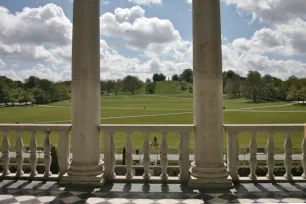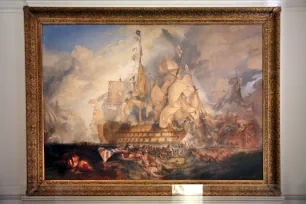The Queen’s House was built in 1616-1638 for Anne of Denmark, Queen consort of James I. The house, which is home to a collection of paintings from the National Maritime Museum, marked a milestone in the architectural history of England.
History


Queen Anne of Denmark wasn’t too happy with the old Palace of Placentia in Greenwich so her husband James I instructed Inigo Jones, surveyor-general of the King’s Works, to build a new summer house near the old palace. Jones had just returned from a visit to Italy which inspired him to design England’s first building in Palladian style, a style heavily influenced by classical architecture.
Construction of the house started in 1616, but when Queen Anne died three years later, the building was left unfinished. In 1632 construction resumed when King Charles I decided to complete the house for his wife, Henrietta Maria of France. The house was finally finished in 1638 by John Webb, assistant and son-in-law of Inigo Jones.
The Queen’s House was only sparingly used by the royals, who preferred to reside at the much larger Hampton Court Palace. In 1690 the house became the residence of the Ranger of Greenwich Park. In 1806 King George III donated the house to the Royal Naval Asylum, a school created for orphaned children of military personnel who were killed in action. The school moved to another location in 1933. The house was restored and opened to the public four years later, in 1937, as the National Maritime Museum.
Architecture




The Queen’s House had a significant impact on English architecture. It was the first neoclassical building in the country, and it contrasted starkly with the then-prevalent Elizabethan architecture, which was often characterized by turrets and towers.
The building’s design looks simple but elegant, with a rectangular layout and just two stories topped with a flat balustraded roof. The south side was designed as the front facade, and features a loggia with Ionic columns on the first floor, which overlooks Greenwich Park. The other side, facing the river, features a wide double staircase. The open colonnades that connect the house with the annexes were built much later, in 1807, to designs by Daniel Alexander.
Interior
The main entrance on the north side leads straight to the Great Hall, a perfect cube measuring twelve meters (40 ft) on each side. The beautiful black-and-white patterned marble floor was laid by Nicholas Stone, the master mason of Charles I. The ceiling was decorated in 1636-1638 with paintings created by Orazio Gentileschi. Unfortunately, they were removed in 1708 and now adorn Marlborough House.
To the left is the Tulip Staircase, the first self-supporting stairs in England. It is named for the flower decorations on the iron handrail, even though these probably depict lilies. The lily-motif, symbol of France, reappears in the Queen’s Cabinet, where it is intertwined with acanthus leaves and accompanied by royal monograms that symbolize the marriage between King Charles I and Henrietta Maria of France. The most interesting room is the Queen’s Bedroom, which is decorated with an eighteenth century ceiling painting of ‘Aurora Dispersing the Shades of Night’ that replaced the original painting from 1640.
Art Gallery

The Queen’s House was the original location of the National Maritime Museum. The main collection of the museum is now housed in a separate, larger building, but you can still admire a fine selection of nautical paintings in the Queen’s House. The paintings illustrate the illustrious history of the Royal Navy, and show naval battle scenes and portraits of some of England’s heroes. The most famous work is the ‘Battle of Trafalgar’, a large canvas painting created by Joseph Mallord William Turner. The painting was commissioned in 1822 by King George IV, who intended it for the state room of St. James’s Palace.

